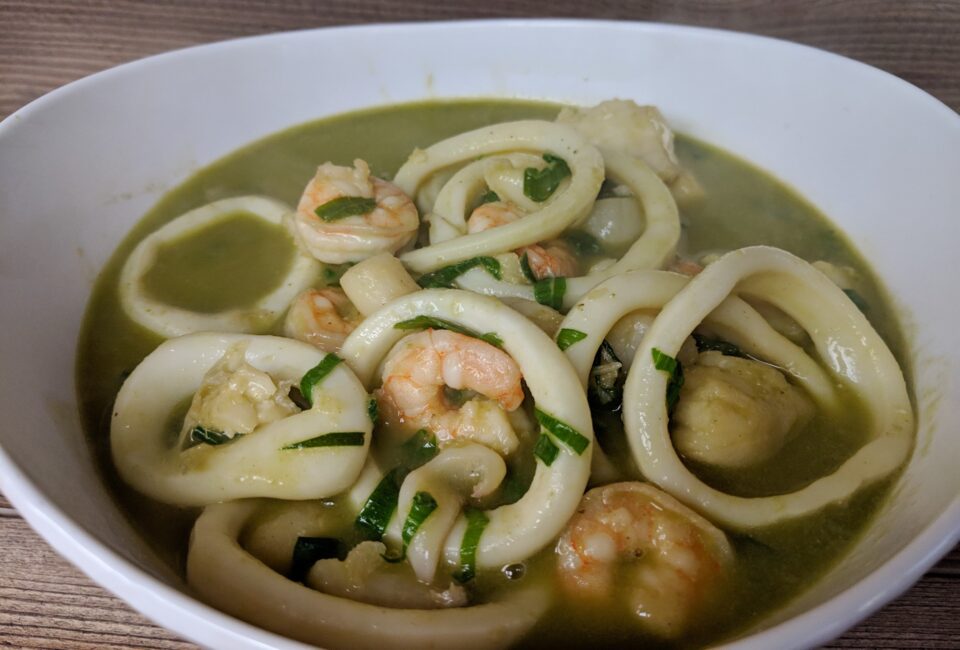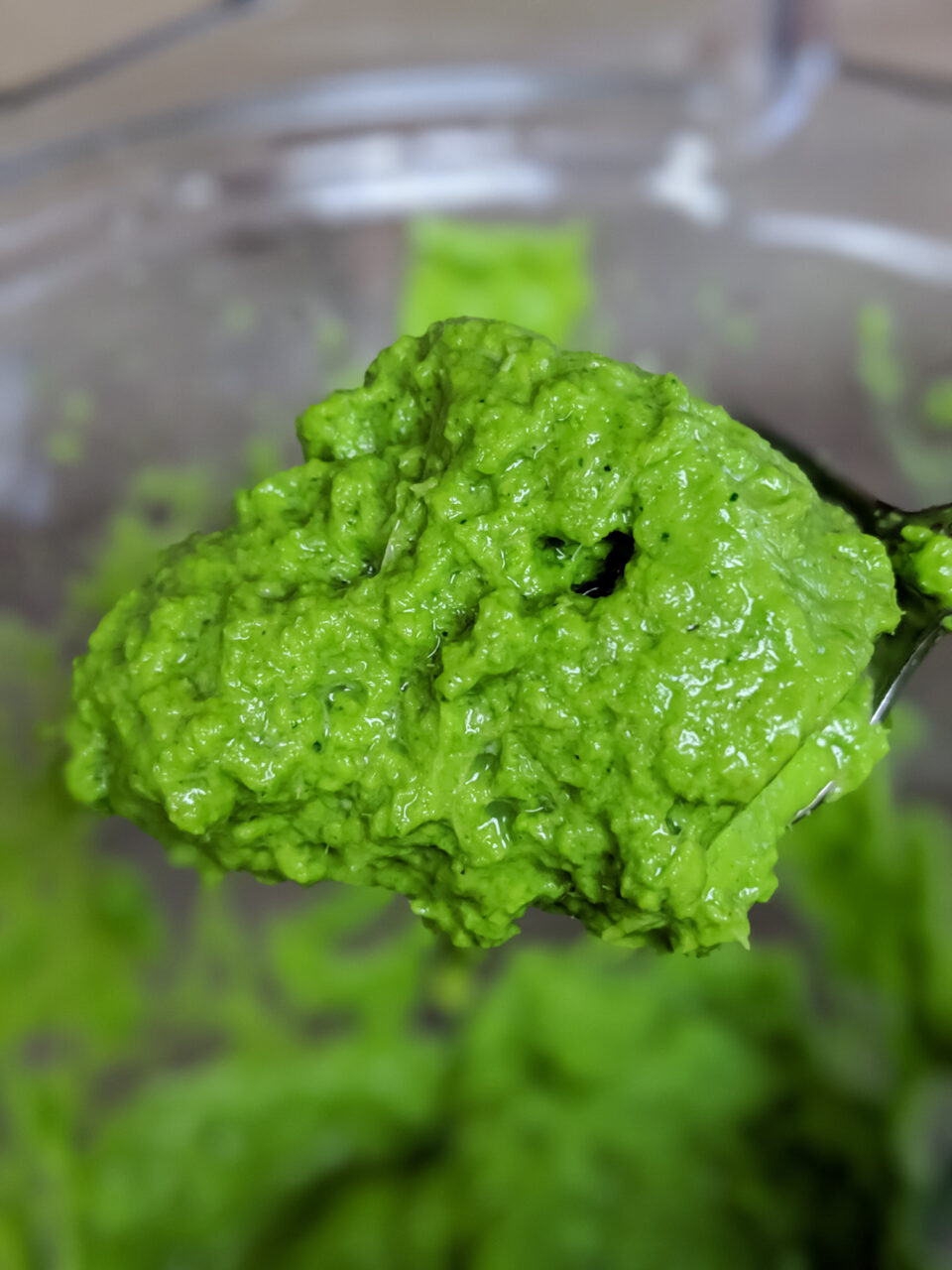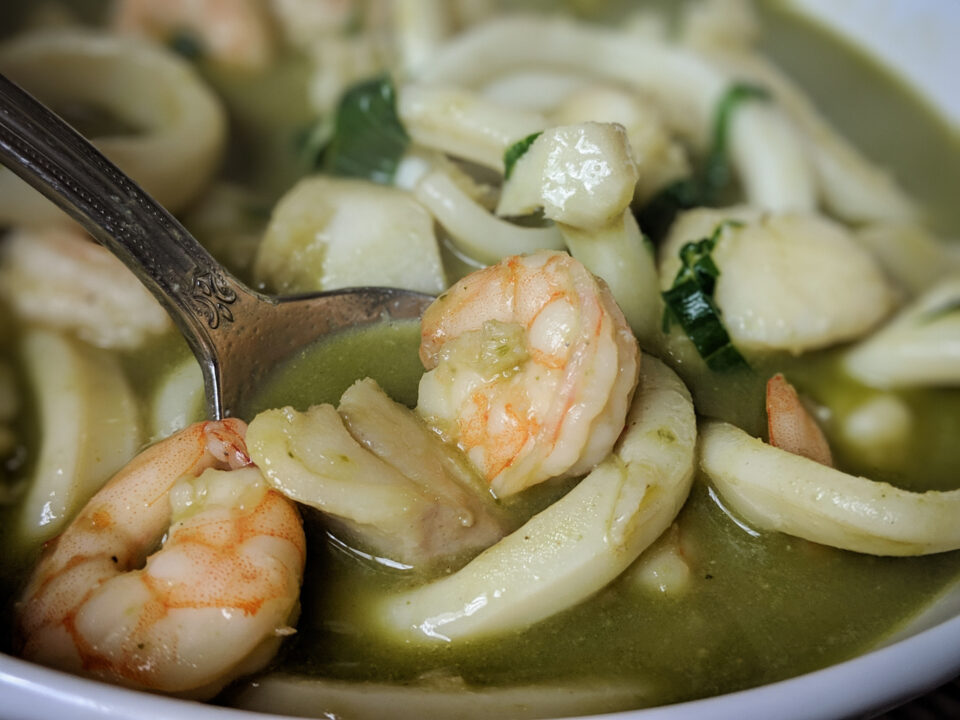This is a slightly milder form of Thai green curry that works great with seafood. You could use a store bought curry paste but after making a homemade version, you wouldn’t go back to buying a curry paste from the store. It takes some effort to gather all the right ingredients but it is worth the effort. I usually tend to make curry pastes in big batches, you can jar or freeze the paste. Use it for the next few months until it’s time to visit the Asian grocery store again.

Homemade Green curry paste vs Store Bought
The advantage is the customization. With homemade you have the control to modify the quantity of each ingredient and spice level. The heat in green curry is from Thai green chilies and you can decide how many of these you want to add to the paste. The other advantage is the use of fresh herbs and spices in green curry makes a huge difference in boosting the flavors in the curry.
What makes Green Curry Green?
Green curry has been my favorite of all types of Thai Curries. The Thai word for it Kaeng khiao wan, Kaeng meaning curry and Khiao wan meaning green. So what makes it green? It’s all the fresh herbs that go in it. The freshness and mild, but beautiful flavors of the fresh herbs pairs perfectly with fish, oysters, clams, shrimp.
How to make the Green Curry Paste?
It is the simplest curry paste to make from scratch and you will find most of these ingredients in any Asian grocery market or even in stores like Whole Foods.
Once you have all of these ingredients, getting them ready to go into the processor and turning it into a paste takes only a few minutes and the benefits of the fresh paste are worth it.
Ingredients for the Green Curry Paste
- 6 Spring Onions
- 6-7 Fresh Cilantro Stems coarsely chopped (Optional)
- 8 Kaffir Lime leaves shredded
- 1-3 Thai green Chilies (if you like the heat), if not Serrano works too
- 4 lemongrass stalks (bottom tender portion only), coarsely chopped
- 1 inch piece of Galanga, skin peeled and coarsely chopped
- 2 inch piece of ginger, skin peeled and coarsely chopped
- 10-12 of fresh Thai Basil leaves
- 4-tbsp of vegetable oil
- 1tbsp salt
Put all of these into a food processor and blend until you get a smooth paste. You may need to add 1-2 tbsp of water or additional oil if you prefer to get to the smooth texture.
You can use the paste right away to make the curry or you can put it in a jar, refrigerate or freeze the paste until you are ready to use it. With the amount here I can make this seafood curry recipe at least 2 -3 times, depending on the concentration of flavors you like in your curry.

How do you make Seafood Green Curry?
You can use just fish, if you prefer. A light fish like Cod or Barramundi works well. My favorite curry is a seafood mix including fish, shrimp, scallops, mussels, squid rings. The creaminess of the coconut milk and the flavors of the fresh herbs pairs really well with any seafood.
For the curry you will need,
Ingredients:
- 2.5lbs bag of mixed seafood (shrimp, mussels, scallops and calamari). I get this from Costco. If not, just any such combination will do.
- 2 small fillets of Cod, cut into 2 inch pieces
- 4-5 kaffir lime leaves, shredded, or cut into thin strips.
- 2-3 fresh Thai or Serrano chilies, seeded and cut into strips (optional for additional heat)
- 2 cans of coconut milk
- Handful of torn Thai Basil leaves
- 2-3tbsp of Thai fish sauce
- 3-4 green parts of the Spring Onions for garnish, minced
- Squeeze of lime juice
Key Tips –
- If you not into Thai Fish Sauce (yes, it is super stinky, but adds a delicious flavor), you can use soy sauce.
- For coconut milk, I prefer the full fat coconut milk with seafood. For chicken, a little less creamy works better. You can use one can of full fat coconut with 1 can of reduced fat coconut milk.
- You do not want to overcook the curry sauce, coconut milk can get slimy as it overcooks. I split up the additions of coconut milk to avoid this. Avoid bringing coconut milk to a boil, should always stay in a state of mild simmer.
- While cutting up Kaffir Lime leaves, take out the central vein, it is tough and will not taste good in the curry. To cut up Kaffir lime, roll up a few after taking the central vein out and cut it into very fine strips.
- While using Lemongrass, only use the bottom 1-2 inches that are tender. Take out the most of the tough layers until you get to the tender part of the stalk. Remove the tough base as well.
- It’s important not to overcook the squid, it will turn chewy. As soon as shrimp gets slightly pink, you can stop. It shouldn’t take more than a few mins if there is no liquid. If the seafood is frozen, completely thaw it out and strain all liquid before stir frying. Also if the wok isn’t large enough, cook the seafood in installments. If you overcrowd the wok, the seafood will steam, release water and overcook.
Method to make the curry
- In a large wok, heat up some oil. When hot add the seafood mix and cook until the shrimp turns just pink. If using mussels either use cooked mussels or cook it separately until mussels open up and are cooked.
- Transfer the cooked seafood onto a plate while you are making the curry sauce.
- Add 1 can of coconut milk to the same wok and add 1/4 to 1/3rd cup of the paste, the fish sauce and shredded kaffir lime leaves to the hot coconut milk and stir well to mix. You can use close to half of the paste that you made.
- Bring this mix to a simmer, then reduce heat to maintain simmering gently for 10 mins
- Add the 2nd can of coconut milk to the wok and stir and continue to cook until it is heated through and comes up to simmer. This should take a couple mins.
- Add the chunks of fish to the sauce 1st, and after a couple minutes or so add the cooked seafood.
- Adjust seasoning. Cook until the seafood is heated through, a few more mins, not more. You do not want to overcook the seafood.
- When heated through, add in the green chilies (if using), scallions and torn basil leaves.
- Serve with freshly cooked hot Thai Jasmine rice and couple lime wedges on the side. Squeeze of lime into the curry just before you eat.

You may substitute seafood for chicken or tofu if you prefer. When I use seafood, I do not use any other vegetables. But if you are using chicken, you could add other vegetables like eggplant or peas. You can use thinly sliced chicken or precooked chicken breasts to the curry sauce. The other option with chicken is to marinate the chicken in some curry paste and soy sauce, stir fry the chicken prior to adding it to the curry sauce. Enjoy!